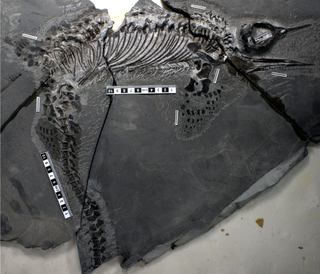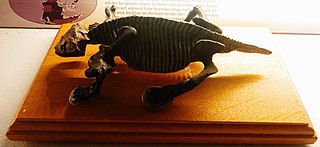 W
WArchaeornithomimus is a genus of ornithomimosaurian theropod dinosaur that lived in Asia during the Late Cretaceous period, around 96 million years ago in the Iren Dabasu Formation.
 W
WArchaeothyris is an extinct genus of ophiacodontid synapsid that lived during the Late Carboniferous and is known from Nova Scotia. Dated to 306 million years ago, Archaeothyris, along with a more poorly known synapsid called Echinerpeton, are the oldest undisputed synapsids known. The name means ancient window (Greek), and refers to the opening in the skull, the temporal fenestra, which indicates this is an early synapsid. Protoclepsydrops also from Nova Scotia is slightly older but is known by very fragmentary materials.
 W
WAzendohsaurus is an extinct genus of herbivorous archosauromorph reptile from roughly the late Middle to early Late Triassic Period of Morocco and Madagascar. The type species, Azendohsaurus laaroussii, was described and named by Jean-Michel Dutuit in 1972 based on partial jaw fragments and some teeth from Morocco. A second species from Madagascar, A. madagaskarensis, was first described in 2010 by John J. Flynn and colleagues from a multitude of specimens representing almost the entire skeleton. The generic name "Azendoh lizard" is for the village of Azendoh, a local village near where it was first discovered in the Atlas Mountains. It was a bulky quadruped that unlike other early archosauromorphs had a relatively short tail and robust limbs that were held in an odd mix of sprawled hind limbs and raised forelimbs. It had a long neck and a proportionately small head with remarkably sauropod-like jaws and teeth.
 W
WBrontoscorpio anglicus is a species of fossil scorpion. Its remains were discovered in Upper Silurian-aged sandstone from Trimpley, Worcestershire, and the species was described on the basis of an incomplete single free finger of a pedipalp, almost 10 centimetres (3.9 in) long. The complete animal is estimated to have been at least 90 centimetres (35 in) long.
 W
WChaohusaurus is an extinct genus of basal ichthyopterygian, depending on definition possibly ichthyosaur, from the Early Triassic of Chaohu and Yuanan, China.
 W
WDeinogalerix is an extinct genus of gymnure which lived in Italy in the Late Miocene, 7-10 million years ago. The genus was apparently endemic to what was then the island of Gargano, which is now a peninsula. The first specimens of Deinogalerix were first described in 1972.
 W
WEchinerpeton is an extinct genus of synapsid, including the single species Echinerpeton intermedium from the Late Carboniferous of Nova Scotia, Canada. The name means 'spiny lizard' (Greek). Along with its contemporary Archaeothyris, Echinerpeton is the oldest known synapsid, having lived around 308 million years ago. It is known from six small, fragmentary fossils, which were found in an outcrop of the Morien Group near the town of Florence. The most complete specimen preserves articulated vertebrae with high neural spines, indicating that Echinerpeton was a sail-backed synapsid like the better known Dimetrodon, Sphenacodon, and Edaphosaurus. However, the relationship of Echinerpeton to these other forms is unclear, and its phylogenetic placement among basal synapsids remains uncertain.
 W
WGallimimus is a genus of theropod dinosaur that lived in what is now Mongolia during the Late Cretaceous period, about seventy million years ago (mya). Several fossils in various stages of growth were discovered by Polish-Mongolian expeditions in the Gobi Desert of Mongolia during the 1960s; a large skeleton discovered in this region was made the holotype specimen of the new genus and species Gallimimus bullatus in 1972. The generic name means "chicken mimic", referring to the similarities between its neck vertebrae and those of the Galliformes. The specific name is derived from bulla, a gold capsule worn by Roman youth, in reference to a bulbous structure at the base of the skull of Gallimimus. At the time it was named, the fossils of Gallimimus represented the most complete and best preserved ornithomimid material yet discovered, and the genus remains one of the best known members of the group.
 W
WGracilisuchus is an extinct genus of tiny pseudosuchian from the Late Triassic of Argentina. It contains a single species, G. stipanicicorum, which is placed in the clade Suchia, close to the ancestry of crocodylomorphs. Both the genus and the species were first described by Alfred Romer in 1972.
 W
WGraecopithecus is a hominin originally identified by a single mandible found in Greece in 1944. Since then, analysis of tooth specimens, dated to 7.2 million years ago, has led to suggestions that Graecopithecus may have been the oldest direct ancestor of humans excluding the chimpanzee lineage, or alternatively the last common ancestor of both humans and chimpanzees, though other scientists are skeptical of these claims. The creature was nicknamed 'El Graeco' by scientists.
 W
WGraecopithecus is a hominin originally identified by a single mandible found in Greece in 1944. Since then, analysis of tooth specimens, dated to 7.2 million years ago, has led to suggestions that Graecopithecus may have been the oldest direct ancestor of humans excluding the chimpanzee lineage, or alternatively the last common ancestor of both humans and chimpanzees, though other scientists are skeptical of these claims. The creature was nicknamed 'El Graeco' by scientists.
 W
WHanosaurus is an extinct genus of pachypleurosaurs that existed during the Triassic period in what is now China. It was described by Young in 1972, and the type species is Hanosaurus hupehensis.
 W
WKawingasaurus is an extinct genus of dicynodont therapsid from the Late Permian. It is a member of the family Cistecephalidae, and like other cistecephalids it is thought to have been fossorial.
 W
WKimberella is an extinct genus of bilaterian known only from rocks of the Ediacaran period. The slug-like organism fed by scratching the microbial surface on which it dwelt in a manner similar to the gastropods, although its affinity with this group is contentious.
 W
WLewisuchus is a genus of archosaur that lived during the Middle Triassic (Ladinian). As a silesaurid dinosauriform, it was a member of the group of reptiles commonly considered to be the closest relatives of dinosaurs. Lewisuchus was about 1 metre (3.3 ft) long. Fossils have been found in the Chañares Formation of Argentina. It exhibited osteoderms along its back.
 W
WOncorhynchus rastrosus also known as the sabertooth salmon, is an extinct species of salmon that lived along the Pacific coast of North America, first appearing in the late Miocene in California, then dying out some time during the Early Pliocene. Adults grew to be 2.7 m (9 ft) in length and are believed to have been anadromous like their living relatives. Besides being the largest member of the Pacific salmon genus Oncorhynchus, members of this species had a pair of small "fangs" protruding from the tip of the snout, thus explaining the common name and synonym. Beyond their fangs, adults of O. rastrosus had larger gill rakers compared to their smaller, modern relatives, leading scientists to suggest that the adults ate plankton.
 W
WRegisaurus is an extinct genus of small carnivorous therocephalian. It is known from a single described species, the type species Regisaurus jacobi, from the Early Triassic Lystrosaurus Assemblage Zone of South Africa, although at least one undescribed species is also known.
 W
WRivero's barn owl is an extinct species of barn owl that was very large — bigger than any extant barn owl species, and possibly larger than any known owl alive today. It is thought to have been nearly as large as another extinct gigantic owl, Ornimegalonyx. Suárez and Olson demoted T. riveroi as a junior synonym of Tyto pollens in 2015.
 W
WStegodibelodon is an extinct genus of elephant or gomphothere from the Miocene.
 W
WViaphacops is a genus of trilobites in the order Phacopida, family Phacopidae, that lived during the Middle Devonian, and is known from North and South America, Asia.
 W
WVulcanodon is an extinct genus of sauropod dinosaur from the Early Jurassic of southern Africa. The only known species is V. karibaensis. Discovered in 1969 in Rhodesia, it was regarded as the earliest-known sauropod for decades, and is still one of the most primitive sauropods that has been discovered. As a quadrupedal, ground-dwelling herbivore, Vulcanodon already showed the typical sauropod body plan with column-like legs and a long neck and tail. It was smaller than most other sauropods, measuring approximately eleven metres (36 ft) in length. Vulcanodon is known from a fragmentary skeleton including much of the pelvic girdle, hindlimbs, forearms, and tail, but lacking the trunk and neck vertebrae as well as the skull.